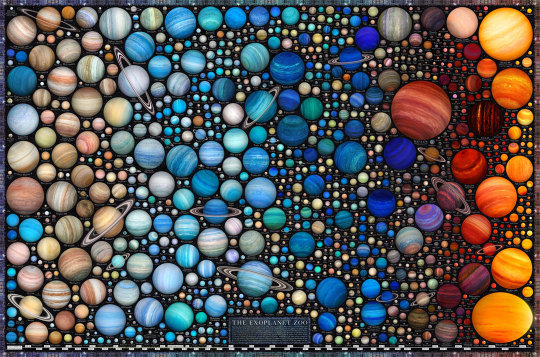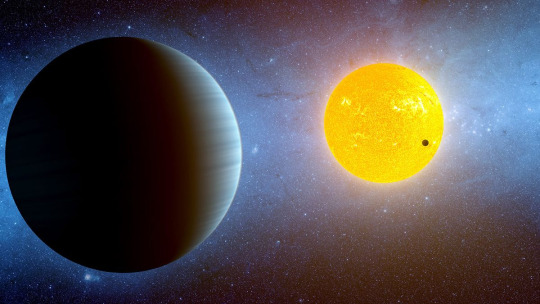#kepler-10c
Explore tagged Tumblr posts
Text
10 of the Weirdest Exoplanets Discovered So Far
The cosmos is vast and mysterious, with billions of stars, each potentially hosting planets of its own. As our technology advances, we’ve been able to detect and study exoplanets—planets outside our solar system—with increasing precision. Here, we’ll delve into ten of the most bizarre exoplanets discovered up to 2022, presenting them with analogies to help you grasp their peculiarities. J1407b:…

View On WordPress
#55 Cancri e#celestial mysteries#cosmic wonders#diamond planet#exoplanets#gas giants#GJ 1214b#Gliese 436 b#HD 189733b#J1407b#Kepler-10c#planetary discoveries#PSR J1719-1438 b#space exploration#TrES-2b#WASP-12b#WASP-39b#water world#weirdest exoplanets
2 notes
·
View notes
Text



Название планеты Kepler-10c находится в созвездии дракона на расстояние от земли 64 световых лет планета имет твердою поверхность масу планеты в 17 раз больше чем у земли это очень большая планета с очень твердый поверхности проще всего мега земля.
0 notes
Text
okay guys im pretty sure the entire mass of kepler-10c has stopped hanging out in my headspace and so we will have. askbox tuesday
1 note
·
View note
Text
0 notes
Photo
Kepler-10c is the Godfather of them all 🪐

Plans B, Exoplanet Zoo - Martin Vargic, Halcyon Maps (larger)
246 notes
·
View notes
Text

Why Exoplanet Kepler 10c Was Downgraded From 'Mega-Earth' http://dlvr.it/Sr9tP1
0 notes
Photo

«Kepler-10c» — новый альбом композитора Игоря Склярова
Вышел новый альбом композитора Игоря Склярова «Kepler-10c» посвященный одноименной экзопланете, обращающейся вокруг одной и�� относительно близких к Солнцу звёзд в созвездии Дракона.
Каждый из семи треков альбома является своего рода музыкальной иллюстрацией той или иной визуальной картины, которую могли бы увидеть путешественники, прибывшие на планету «Kepler-10c». Музыка в стиле 'эмбиент' и 'романтик нойз' на протяжении альбома довольно монолитна, и паузы между треками могут оказаться совершенно незаметны. Она формирует спокойное созерцательное настроение, рождает многослойные зрительные образы, которые с высокой долей вероятности могут соответствовать происходящему на поверхности этой далекой и таинственной планеты.
С 10-го мая 2019 года альбом «Kepler-10c» композитора Игоря Склярова доступен для свободного прослушивания на сайте NEANE Records, а так же может быть скачан (инструкция странице альбома) или заказан в виде CD.
http://neane.ru/rus/4/katalog/2407.htm
0 notes
Video
youtube
Gigantischer Gesteinsplanet - Supererde Kepler 10c sprengt alle Rekorde
0 notes
Photo

'Godzilla of Earths': Alien Planet 17 Times Heavier Than Our World Discovered
Scientists have just discovered the "Godzilla of Earths" — a new type of huge and rocky alien world about 560 light-years from Earth.
Dubbed a "mega-Earth," the exoplanet Kepler-10c weighs 17 times as much as Earth and it circles a sunlike star in the constellation Draco. The mega-Earth is rocky and also bigger than "super-Earths," which are a class of planets that are slightly bigger than Earth.
Continue Reading
807 notes
·
View notes
Photo

Harvard astronomers just found the "Godzilla of Earths"
On Monday, astronomers from the Harvard-Smithsonian Center for Astrophysics announced their discovery of a so-called "mega-Earth": a planet called Kepler-10c that is about twice the size of and 17 times heavier than our own. And by all accounts, it shouldn't exist.
Read more | Follow policymic
669 notes
·
View notes
Photo

An artist's illustration of the mega-Earth planet Kepler-10c, the"Godzilla of Earths" planet that is 2.3 times the size of Earth and 17 times heavier. The planet and its lava-world sibling Kepler 10b (background) orbit the star Kepler-10 about 570 light-years from Earth, in the constellation Draco.
Strangest Alien Planets
#Kepler-10c#kepler 10b#kepler 10#draco#constellation draco#draco constellation#space art#space#alien planet#planet#planets#outer space#nature#science#astronomy#mega earth#fuckyeah stars#traverse our universe#mine
394 notes
·
View notes
Photo

Astronomers Find New Type of Planet: Rocky like Earth; Huge like Jupiter KEPLER-10c — The "Godzilla of Earths" Monday, June 2, 2014 - Harvard-Smithsonian Center for Astrophysics
Astronomers announced today (June 2, 2014) that they have discovered a new type of planet - a rocky world weighing 17 times as much as Earth.
Theorists believed such a world couldn't form because anything so hefty would grab hydrogen gas as it grew and become a Jupiter-like gas giant. This planet, though, is all solids and much bigger than previously discovered “super-Earths,” making it a “mega-Earth.” “
We were very surprised when we realized what we had found,” says astronomer Xavier Dumusque of the Harvard-Smithsonian Center for Astrophysics (CfA), who led the data analysis and made the discovery.
“This is the Godzilla of Earths!” adds Dimitar Sasselov, director of the Harvard Origins of Life Initiative. “But unlike the movie monster, Kepler-10c has positive implications for life.”
The newfound mega-Earth, Kepler-10c, circles a sunlike star once every 45 days. It is located about 560 light-years from Earth in the constellation Draco. The system also hosts a 3-Earth-mass “lava world,” Kepler-10b, in a remarkably fast, 20-hour orbit.
Continue reading today's press release ...
Also reported by Smithsonian Science, Caltech's Jet Propulsion Laboratory, the International Business Times, EurekaAlert, ... _______________________________________
IMAGE: Artist’s Rendering Of The Kepler-10 System And Its Mega-Earth The newly discovered ‘mega-Earth’ Kepler-10c dominates the foreground in this artist’s conception. Its sibling, the lava world Kepler-10b, is in the background. Both orbit a sunlike star. Kepler-10c has a diameter of about 18,000 miles, 2.3 times as large as Earth, and weighs 17 times as much. Therefore it is all solids, although it may possess a thin atmosphere shown here as wispy clouds. Credit: David A. Aguilar (Harvard-Smithsonian Center for Astrophysics)
#astronomy#breaking news#mega-earth#godzilla of earths#Kepler-10c#astrophysics#jbwii#jbwau#exoplanet
122 notes
·
View notes
Photo

Newly discovered mega-Earth challenges the idea that big planets can't support life.
(Photo: Harvard-Smithsonian Center for Astrophysics)
80 notes
·
View notes
Link
Astronomers have discovered a rocky planet that weighs 17 times as much as Earth and is more than twice as large in size. This discovery has planet formation theorists challenged to explain how such a world could have formed.
The Kepler mission has provided yet more stimulus for planetary science by finding a planet larger than expected for a rocky, Earth-like planet (Kepler-10c, 17 times the mass of Earth and more than twice as large in size).
According to current theories of planet formation, the gravity of a planet of this size should have captured large amounts of gases, mostly hydrogen and helium, which would have turned the planet into a gas giant.
Kepler-10c is close in to its sun-like star and orbits every 45 days, so if the planet had followed the anticipated course of development it would have been a Hot Jupiter (or, if you prefer, an epistellar Jovian), but Kepler-10c is apparently a Hot Jupiter that never happened, and, like the dog that didn't bark in the night, we want to know why. Is this the result of some mechanism of planet formation of which we were heretofore unaware, or might it be a freakish exception, the result of some ancient planetary cataclysm (say, for example, a collision that tore away most of the atmosphere)?
You could think of Kepler-10c as a "failed" Hot Jupiter, in the way that brown dwarfs are sometimes called "failed" stars, and some theorists of the anthropic cosmological principle call a universe without life (i.e., life capable of reflexively observing that universe) a "failed" universe, but this is to import unacceptable teleological conceptions into planetary science.
Keep in mind that, before the discovery of a great many Hot Jupiters (which, as exoplanets, are relatively easy to discover because their gravity tugs significantly at the star they orbit), these too were considered unlikely. All the gas giants in our solar system occupy outer orbits, so if you take our solar system as normative (i.e., if you relinquish a Copernican perspective), a Hot Jupiter seems like a planetological pathology.
Also cf. Mega-Earth is a huge, rocky new kind of planet: Planets this big were thought to be always gassy
21 notes
·
View notes
Link
Scientists have just discovered the "Godzilla of Earths" — a new type of huge and rocky alien world about 560 light-years from Earth.
Dubbed a "mega-Earth," the exoplanet Kepler-10c weighs 17 times as much as Earth and it circles a sunlike star in the constellation Draco. The mega-Earth is rocky and also bigger than "super-Earths," which are a class of planets that are slightly bigger than Earth.
Theorists weren't actually sure that a world like the newfound exoplanet could exist. Scientists thought that planets of Kepler-10c's size would be gaseous, collecting hydrogen as they grew and turning into Jupiter-like worlds. However, researchers have now found that the newly discovered planet is rocky, Christine Pulliam, a spokeswoman with the Harvard-Smithsonian Center for Astrophysics, wrote in a statement announcing the find. [The Strangest Alien Planets Ever Found (Gallery)]
"This is the Godzilla of Earths!" the CfA's Dimitar Sasselov, director of the Harvard Origins of Life Initiative, said of Kepler-10c in a statement. "But unlike the movie monster, Kepler-10c has positive implications for life."
The discovery of Kepler-10c was presented today here at the 224th American Astronomical Society meeting.
The mega-Earth orbits its parent star once every 45 days. Kepler-10c is probably too close to its star to be hospitable to life, and it isn't the only orbiting the yellow star. Kepler-10 also plays host to a "lava world" called Kepler-10b that is three times the mass of Earth and speeds around its star in a 20-hour orbit.
16 notes
·
View notes
Link
My new blog which looks at analogies and metaphors, and what happens when they are used poorly.
Check out my latest post on "Godzilla-sized Earth" Kepler-10c, which is not actually "Godzilla-sized" (it is a fairly in-depth discussion).
Please check it out at the link or at the Wordpress site: http://aseriesofanalogies.wordpress.com.
Thank you
2 notes
·
View notes